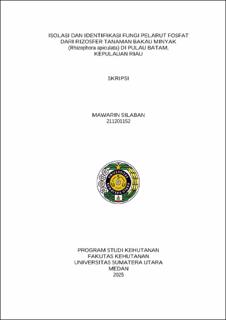Isolasi dan Identifikasi Fungi Pelarut Fosfat dari Rizosfer Tanaman Bakau Minyak (Rhizophora apiculata) di Pulau Batam, Kepulauan Riau
Isolation and Identification of Phosphate Solubilizing Fungi from the Rizosphere of Bakau Minyak (Rhizophora apiculata) in Batam Island, Riau Islands

Date
2025Author
Silaban, Mawarin
Advisor(s)
Susilowati, Arida
Elfiati, Deni
Metadata
Show full item recordAbstract
Pandang Tak Jemu (PTJ) and Rumpun Bakau Indah (RBI) Mangrove Forest Ecosystems in Batam Island have different characteristics for ecosystem balance. PTJ is rich in mangrove species that protect the coast, while RBI focuses on mangrove ecosystem restoration. The study aimed to identify phosphate-solubilizing fungi from the rhizosphere of Bakau Minyak (Rhizophora apiculata) and test their potential in dissolving phosphate. This study aims to identify phosphate-solubilizing fungi from the rhizosphere of oil mangrove plants (Rhizophora apiculata) and test their potential in dissolving phosphate. Soil sampling was conducted using the diagonal method at a 0-20 cm depth, resulting in 10 composite soil samples from two locations. The results of the analysis showed differences in soil chemistry characteristics, with RBI pH recorded at 6,35 and PTJ at 5,07. The highest C-organic content was found in RBI soil (5,75%) compared to PTJ (3,45%). Mangrove soils at both locations showed a very high cation exchange capacity, 55,00 cmol/kg at RBI and 45,10 cmol/kg at PTJ. Phosphate-solubilizing fungi (FPF) at both sites showed differences in the mechanism of action based on salinity, with RBI 5,00 mmhos/cm and PTJ 4,00 mmhos/cm. A total of 40 isolates of phosphate-solubilizing fungi were obtained, consisting of 16 isolates from RBI and 24 isolates from PTJ. Microscopic observations showed two genera of fungi, namely Aspergillus and Penicillium. Each isolate showed varying phosphate solubilizing ability, with the best isolate having the highest phosphate solubilizing index on the phosphate source Ca3(PO4)2 of 3.50. These findings suggest that Ca3(PO4)2 is the most effective phosphate source for fungi to solubilize, related to the ability of organic acids to form stable complexes with metal cations in soil minerals.
Collections
- Undergraduate Theses [2162]
